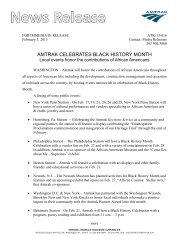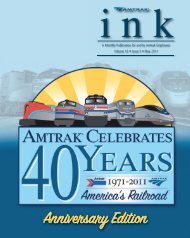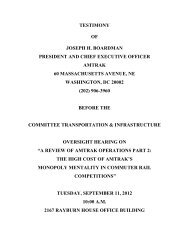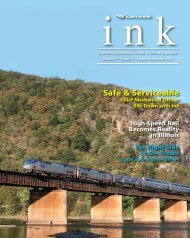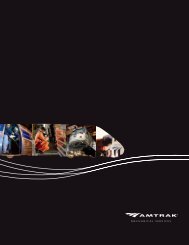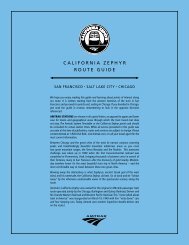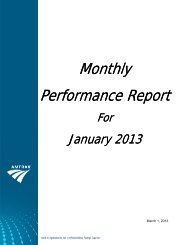November 2010 - Amtrak
November 2010 - Amtrak
November 2010 - Amtrak
- TAGS
- november
- amtrak
- www.amtrak.com
Create successful ePaper yourself
Turn your PDF publications into a flip-book with our unique Google optimized e-Paper software.
8 | <strong>November</strong> <strong>2010</strong> <strong>Amtrak</strong> Ink<br />
A complex logistical operation and consumer promotion, the Disney’s Christmas<br />
Carol Train Tour delivered the highest earned media value in <strong>Amtrak</strong>’s history. The<br />
team’s goal was for the company to generate at least $4 million in earned media value<br />
and the campaign actually exceeded the goal by 100 percent. Across the country, close to<br />
700,000 people lined up to see the event; in one location alone there were close to<br />
20,000 attendees in one day, many of whom stood in line until midnight.<br />
Disney’s Christmas Carol Train Tour Team Members<br />
Donald E. Cushine, Senior Director System Operations Support<br />
Teresa C. Hughey, Director of Charter and Group Services<br />
Gail B. Reisman, Senior Director National Advertising and Marketing Programs<br />
Michele E. White, Director of Sports and Entertainment Marketing<br />
Payment Card Industry Data Security Standards (PCI-DDS) Team<br />
Information Technology and Finance, Washington, D.C.<br />
The three members of the Payment Card Industry-Data Security Standards (PCI-<br />
DSS) team were responsible for bringing <strong>Amtrak</strong> into compliance with new credit card<br />
regulations regarding payment card security.<br />
<strong>Amtrak</strong> was elevated to a “Level 1 Merchant” by credit card companies in 2009<br />
based on the quantity of debit card and credit card payments that it accepts each year for<br />
passenger tickets, and food and beverage services. With the expectation that new<br />
requirements would be imposed with Level 1 status, a cross-organizational team was<br />
formed in 2008 that identified areas of PCI-DSS requiring remediation.<br />
The team members established a project with to become PCI-DSS compliant and to<br />
pass Level 1 Certification in 2009. After an investigation, the team determined that<br />
<strong>Amtrak</strong> had to implement a number of new technologies and technical fixes, policyrelated<br />
enhancements, and administrative changes to address over 200 issues. On<br />
October 26, 2009, <strong>Amtrak</strong> successfully obtained Level 1 Certification from Trustwave, a<br />
qualified third-party assessment vendor that is responsible for performing PCI<br />
Compliance Certifications.<br />
Payment Card Industry Data Security Standards (PCI-DSS) Team Members<br />
Ronald R. “Ron” Baklarz, Chief Information Security Officer<br />
Franklin C. “Frank” King, Director of Information Security<br />
Janet R. Langenderfer, Senior Director, Credit Cards, Treasurer’s Department, Finance<br />
Police Information Management Systems (PIMS) Project Team<br />
<strong>Amtrak</strong> Police Department – Nationwide<br />
The Police Information Management System (PIMS), the nerve center of the <strong>Amtrak</strong><br />
Police Department (APD), went live after several years of hard work and dedicated<br />
service by the team members.<br />
Assistant Chief of <strong>Amtrak</strong> Police Lisa Shahade notes that the team dedicated countless<br />
hours of time both on and off duty to ensure that this $4 million project was<br />
successfully launched. It was completed ahead of time and came in under budget by<br />
nearly $1 million. The task was clearly defined by a contracted schedule to develop and<br />
implement a system by which the APD could move into the future with a high-tech,<br />
state-of-the-art computer system, and the operational benefits would increase officer<br />
safety through the availability of enhanced data retrieval.<br />
This project not only met, but exceeded, all expectations. Key enhancements include<br />
a redefinition of operational procedures (Dispatch & Police); complete call processing<br />
from receipt of call to written report; enhanced decision-making based on real-time statistical<br />
reports; reduced call processing and dispatch time; and increased officer safety<br />
through the availability of enhanced data retrieval. The PIMS Project Team also left<br />
room for future growth in state of the art technology such as mobile data terminals such<br />
as Blackberry and PDA devices for inputting information.<br />
PIMS Project Team Members<br />
William R. Bessette, Sergeant<br />
Daniel L. Campbell, Contractor/System Administrator<br />
Clifford A. Cordani, Captain<br />
William J. Foster, Sergeant<br />
Ronald K. Gontkof, Detective<br />
Michelle A. Jennings, Administrator IMS Applications<br />
Felix L. Perez, Inspector<br />
Brian P. Ravert, Captain<br />
Lisa A. Shahade, Assistant Chief<br />
Albert R. Winterbottom, Lt. (Retired)<br />
<strong>2010</strong> CHARLES LUNA SAFETY<br />
ACHIEVEMENT AWARD<br />
Generation 2 Transfer Bridge Team<br />
The G2 Transfer Bridge Team was composed of seven dedicated employees who<br />
demonstrated a significant role in improving customer and employee safety.<br />
Previously, the standard procedure for a train-to-train transfer between conventional<br />
equipment was to have passengers make a significant step (sometimes a jump down)<br />
onto the ballast and then climb aboard another train on neighboring track. This had to be<br />
accomplished while making sure passengers didn’t touch both trains at the same time in<br />
order to avoid an electric shock. This process was time consuming, came with a high<br />
risk for injury due to traversing unstable ballast, and was sometimes embarrassing for<br />
passengers and crew that literally had to be pushed up onto the rescue train.<br />
After experiencing train-to-train transfers as a passenger two days in a row, Solomon<br />
Carey Jr. identified a better way to complete this process and raised the issue with his<br />
supervisor, Denise Labencki-Fullmer. His idea centered on the predecessor G1 Transfer<br />
Bridge that was developed for Acela trainsets.<br />
A team consisting of Carey and his colleagues, including Richard Gadbois (who had<br />
experience with the development of the G1 transfer bridge), brought the idea to fruition.<br />
From cradle to grave, the project took approximately one year to complete, and on<br />
October 9, 2009 the first train-to-train transfer with a G2 bridge occurred. The G2 was<br />
assembled in two minutes, and the transfer was completed within 15 minutes. Besides<br />
<strong>Amtrak</strong>, NJT and MARC have also used the G2 Transfer Bridge and have expressed<br />
interest in it. Kate Warr, <strong>Amtrak</strong> Customer Advisory Committee administrator, rides on<br />
the Northeast Corridor about once a week, and personally experienced a transfer using<br />
the G2 bridge after a trespasser strike that caused her train to be annulled. She was<br />
amazed at how quickly the transfer took place, and commented on how orderly, safe and<br />
easy the process was.<br />
Generation 2 Transfer Bridge Team Members<br />
Solomon J. Carey, Jr., Program Manager, OBS Operations<br />
Richard P. Gadbois, Regional Safety Officer<br />
Phyllis F. Gadson-Boykins, Trainmaster<br />
Gregory J. Marzili, CAD Engineer<br />
Michael F. Pollick, Safety Director<br />
Joseph Blair Slaughter, Manager, Vehicle Industrial Design<br />
Lawrence M. Tkachenko, Conductor (Retired)<br />
SAFETY ACHIEVEMENT<br />
Juan J. Bernal<br />
Mechanical Foreman III, Mechanical, San Antonio, Texas<br />
Juan J. Bernal started his career with <strong>Amtrak</strong> on October 6, 1997. He first worked in<br />
the Southwest Division Mechanical department in the Carman Journeyman Division,<br />
and is presently a Mechanical Foreman III in San Antonio.<br />
Trainmaster Ginger Brown recalls that John has demonstrated an unwavering commitment<br />
to passenger and employee safety throughout his years at San Antonio. He is an<br />
active member of the <strong>Amtrak</strong> Texas Safety Committee and has made significant contributions<br />
to the culture of safety in the area under his supervision. In this volunteer<br />
position, John posts safety alerts in the Mechanical department and attends to safety promotions,<br />
compliance with safety gear, posting of the day’s safety rules, and general<br />
observational walks around the work area. John also holds safety briefings with not only<br />
his direct reports but also with mechanical personnel, conductors and engineers.<br />
Many of the Safety Committee’s improvement initiatives were carried out after<br />
hours on John’s personal time. According to those who know him well, he has made<br />
safety his mission, contributing tireless off-duty hours to improving the area around the<br />
San Antonio station.<br />
Joseph F. MacDougall<br />
Mechanical Foreman III, Mechanical, San Antonio, Texas<br />
Joseph “Joe” MacDougall began his career with <strong>Amtrak</strong> in 1992. He has held<br />
various positions such as Unassigned Clerk, Ticket Clerk, Unassigned Extra Board and<br />
presently, Ticket Clerk.<br />
Joe began his term on the Bay District Safety Committee in February 2009 by inventorying<br />
and then repairing all safety deficiencies in the San Joaquin Valley, from baggage<br />
cart/trailer inspections to office furniture and general safety concerns.<br />
PAD Agent Clark Bergrun says, “Joe has a natural ability to foresee and prevent any<br />
potential safety issues. His diplomacy and charisma make his interactions with coworkers<br />
and management beneficial to all.” Assistant Superintendent Anthony Chapa<br />
gives Joe credit for ensuring that the station vehicles are more visible by adding additional<br />
flashing lights and reflective tape. Chapa recounts, “During station walkabouts,<br />
Joe discovered that 80 percent of the automatic doors at the stations did not have a func-




